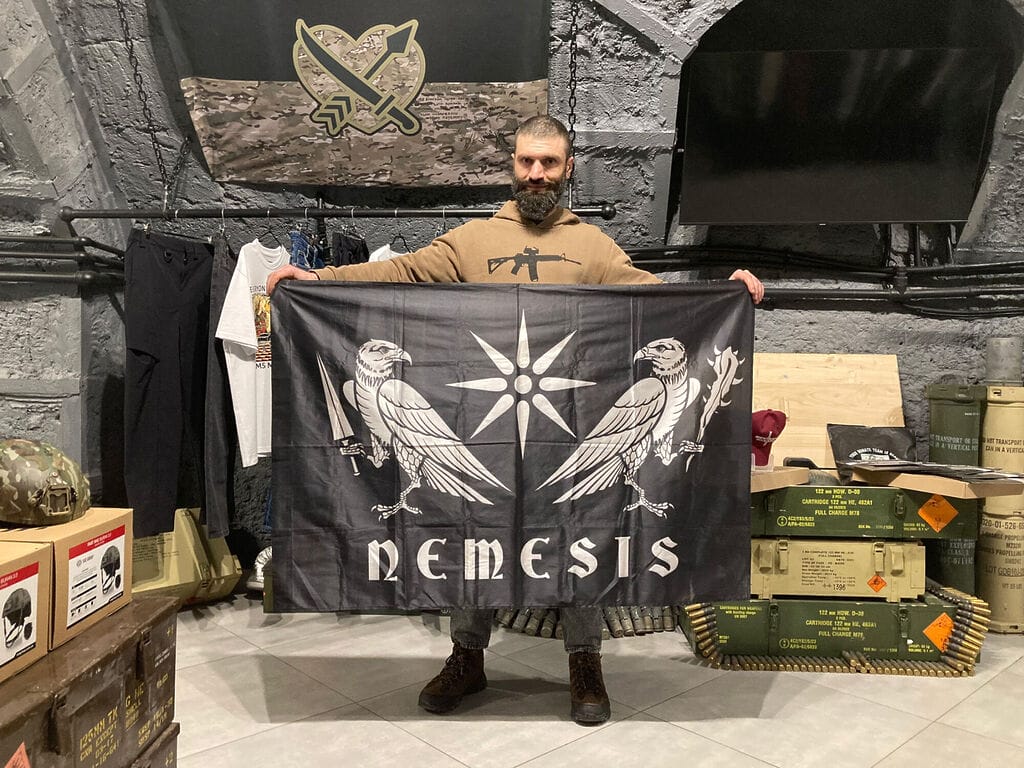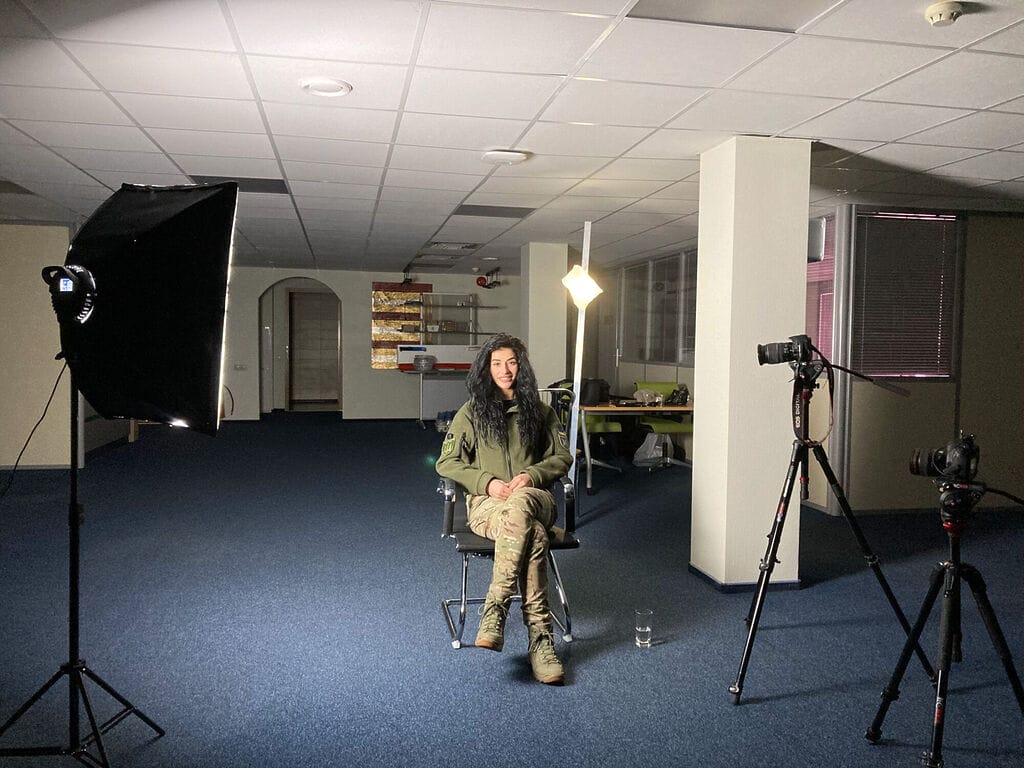Before Russia’s invasion in February 2022, Ukraine was home to one of the world’s largest Armenian communities. After the outburst of the war, many Ukrainian Armenians fled the country. Others chose to take up arms and joined the Ukrainian army. Russian desk went to meet the most determined of these fighters: the members of the Nemesis brotherhood.
— “Send our regards to those *******!”
— “Firing!!!”
We’re covering our ears the best we can. A deafening blast follows. A large-calibre cannon from the 5th Assault Brigade has just opened fire on the Russian army, somewhere in eastern Ukraine. The chief sergeant, call sign “Blogger”, who’s in charge of the operation, winks and smiles slightly at us. The video ends there. The phone seems on the verge of being crushed—this man has got thick hands, from his former days as a professional wrestler, and even more so now from being a professional artillerist. But Blogger, whom we met in Kramatorsk, is known for his precision, both in the handling of his phone and on the front line. He cheerfully explains that his call sign stems from his love of TikTok more than from his computer skills.
Dual Allegiance and Sharing Military Experience
Originally from Luhansk, a city in the Donbas region seized by pro-Russian separatist militias in 2014, this 37-year-old former optician from Kyiv has plenty of reasons to resent the Kremlin’s master. On top of those shared by many Ukrainians, Blogger has his own. Though a Ukrainian citizen, he considers himself indebted to two homelands: Ukraine, where he was born, and Armenia, from where his parents emigrated in the 1970s, looking to find work. Before fighting in Ukraine, Blogger took part in the Nagorno-Karabakh war in 2020, where he fought the Azerbaijani army, and from which he returned severely wounded.
Since then, he’s been convinced that Russia represents an existential threat for both Ukraine and Armenia. “Without Stalin’s intervention” in 1923, Nagorno-Karabakh, “historically populated by Armenians”, would have remained Armenian, he explains. The Russian “peacekeeping” forces deployed in 2020 failed to stop Baku from taking over the region just a few years later. And it is Vladimir Putin’s regime that is responsible for the war that has plagued Ukraine since 2014. This is what motivated Blogger, like all the soldiers we interviewed, to volunteer to join the Ukrainian army in the early months of the full-scale invasion.
Two years into the war, Blogger hears of a group called “Nemesis”. It’s open only to Ukrainian army fighters of Armenian origin or holding Armenian citizenship. They share his views on the Russian threat. He joins them without hesitating.
When we ask him about the group’s purpose, the Russian-speaking artilleryman answers cautiously: “We fight for freedom. Nemesis aims to unite Armenians serving in different brigades. Some are in the artillery, others are snipers… One of our main goals is to share our wartime experience, to exchange advice—because the world has never seen a war like this one, with drones and advanced technology… But I can’t say much more, as the enemy could use this information.

Mutual Support
If one wants to learn more, Blogger says, they’ll have to meet the group’s founder, an enigmatic man known as “Druid”. So that’s what we do, a nineteen-hour train ride later. We meet him in an underground makeshift military warehouse in the Odesa region. “In three years of war,” says Druid, “we’ve become more than just a military discussion group. We’re a big family. We don’t just know each other as soldiers—we know each other’s parents, wives, kids…”
Druid is a reserved man, and a father to three daughters. He worked as a sculptor before the war. Mutual aid, he explains, both practical and financial, is one of the group’s defining features. “In a country where the state still struggles to properly equip its military, even with basic gear, this kind of support is essential.
This solidarity, he adds, extends beyond the fighters. If someone is injured, you’ll get to know their family, and learn about their needs. Sometimes it’s not about money—maybe they just need a good doctor. If one of us knows someone, we’ll help out. That’s how we support each other: by staying in contact, by staying alert.”
In the worst-case scenario, Druid – now a machine gunner and amphibious operations specialist in the Kherson region – says the group helps the families of fallen comrades and organises memorial events. “For the families of fallen soldiers, that support means everything,” he says. His voice is tinged with sorrow.
Informal and Anti-Imperialist
Since its creation in autumn 2022, Nemesis has, despite its informal status, become a true military brotherhood. Its hundreds of members are spread across Ukraine and have never all met in person—only through online chats. The group has no legal existence, but it has its own symbols.
Its emblem, stitched in white thread on a black patch, features the Armenian symbol of eternity over two crossed swords. And its flag features symbols of Tigranes the Great, an ancient Armenian king revered for expanding his empire. The name “Nemesis”, at the bottom of the flag, comes from Operation Nemesis, carried out in the 1920s by the Armenian Revolutionary Federation (the Operation was named after the Greek goddess of divine retribution and aimed to assassinate those most responsible for the 1915 Armenian genocide orchestrated by the Ottoman Empire). “We’re carrying on our ancestors’ cause: fighting empires. It’s revenge against imperialism.”
Fighting Russian Propaganda Against Armenia
The narrative is carefully constructed. One reason Nemesis was founded, Druid says, was to counter Moscow’s propaganda suggesting Armenia is a pro-Russian country. “We were fighting in silence. But the enemy pushed us to create an Armenian organisation. The Russian propaganda machine was going at full throttle, in Ukraine, but also in Armenia. On realising that, we decided to make ourselves visible.” Druid’s tone of voice is determined: “By uniting, we become stronger—and from strength comes freedom.”
One of the most visible examples of this propaganda, he says, is the creation of a Russian-backed private paramilitary group called “Arbat” (stands for Armianski Batalion, meaning “Armenian Battalion” in Russian). Founded in September 2022, Arbat is allegedly made up of Armenians fighting for Russia and is portrayed—by Russia’s Pyatnashka international brigade, on Telegram – as part of the so-called “Donbas Wild Division”.
According to “Cardinal” (who got his call sign from the novel The Three Musketeers), another Nemesis member we met in Kyiv, members of the “Arbat pseudo-battalion” are politically motivated and likely hoping for key positions in Armenia if the country comes to fall under Russian control.
At 37, Cardinal, formerly a police captain and now a military instructor, warns that such a scenario could play out in Armenia and other former Soviet republics if Russia wins in Ukraine. “But that won’t happen,” he says calmly. Arbat’s founder, Armen Sargsyan (wanted by Ukraine since 2014), was assassinated in Moscow in February. According to France24, his unit often recruited prisoners in Russia and may have been involved in plotting a coup in Armenia in 2024.
Cardinal struggles at times to find the right words. His post-war dream is “to sleep a lot”—right now, he gets only four hours a night, far from his family, who is sheltering in western Ukraine. But the interview continues in English, a language he once used to speak with visiting foreign delegations in Ukraine. When asked whether he has a leadership role in Nemesis, he shakes his head: “We’re all equal. We have a mentor—Druid—but he doesn’t act like a boss.”
This flexibility explains the diversity of projects within Nemesis. One idea is to draft an “ethical code for Armenian fighters in Ukraine”, because, Cardinal stresses, “our values are not to be killers, but defenders”. Formerly a member of a reconnaissance unit, he also plans to auction off war trophies to raise funds for members in need.

Future Projects
Druid and Cardinal both believe Nemesis will outlive the war. Druid already has some cultural projects in mind, and Cardinal would like to write a manual for future soldiers. “For guys in our situation – fighting a large army with small groups, dealing with ammo shortages, technological inferiority… I don’t want this knowledge to be lost.” Nemesis may also run youth training camps: teaching first aid, hosting concerts, and encouraging physical activity. “We want to tell our stories, explain that we’re veterans, share what we’ve been through—and prepare others for psychological and physical hardship,” Cardinal adds.
The same concern is shared by “Duchess”, 37, a kamikaze drone pilot who holds three master’s degrees and used to work at a pension fund. We met her in Kyiv. She wants to share her experience “on a larger scale” and is considering opening a school for future drone pilots within Nemesis. “Even if the war freezes or ends, we understand perfectly that it will break out again. We need to be as prepared as possible. I keep saying: kids shouldn’t be playing with smartphones, but with drone controllers.”
A Russian speaker and a mother to a teenage AC/DC fan now living in western Ukraine, Duchess was born in Armenia and raised in Kramatorsk. She experienced the city’s capture by pro-Russian forces in 2014, then its recapture by the Ukrainian army that same year. Since then, the city, bombed regularly, is haunted by its proximity with the front. Duchess won’t reveal much about her own experience or about Nemesis, which she also calls a “big family”. She laughs: “The guys treat me like a queen.”
Allies and Diplomacy
Our interlocutors are deeply skeptical about the possibility of a lasting peace with Russia. The negotiations initiated by Washington are viewed warily—despite security guarantees being discussed by Ukraine’s allies in the US and EU. As Blogger points out, the failure of the 1994 Budapest Memorandum and the Minsk Agreements (2014–2015) has eroded trust in political or diplomatic solutions.
No one here believes Vladimir Putin truly wants to negotiate in good faith. Cardinal warns that any ceasefire would come with Ukrainian elections—where Russia will surely try to meddle. “They’re professionals. Look at what they tried in Moldova,” he says, referring to the interference in the country’s EU referendum and 2024 presidential election that the Kremlin has been accused of.
Trust in the US isn’t always absolute. Vachagan, 28, a political and military commentator and the first civilian volunteer to help Nemesis, explains: “Given the complex situation between Russia and Ukraine, Trump will try to profit from both sides. He’s a businessman. He’s clearly interested in Ukraine’s mineral resources – and also wants to resume trade with Russia.” Vachagan, whom we met in Dnipro, has helped boost the group’s visibility on social media. Estimates suggest the Ukrainian army includes between 15,000 and 25,000 fighters of Armenian origin or holding Armenian citizenship.
Antoine Laurent is a freelance journalist. A contributor to the Swiss bimonthly Echo Magazine, the Italian media Osservatorio Balcani e Caucaso Transeuropa, and other publications on a more ad hoc basis (Le Courrier de Genève, Linkiesta, etc.).